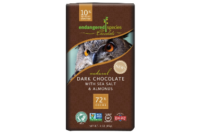
The Amazing Race
By Dan Malovany
What’s new at IBIE 2007? Put on those running shoes, and join our intrepid reporter as he takes a whirlwind tour in his search for innovation at the big bakery show.
Too many exhibitors and too little time can make this reporter feel anything but sublime. Yes, I was in the land that gave birth to Disney World, but there was no time for fun. It was hot and sticky, but I had a job to do, and it was a monster one at that.
The 2007 International Baking Industry Exposition, held last month in Orlando, Fla., was a marathon of a show that lasted four days and had me running around like Mickey Mouse on a hamster wheel. Actually, I could have used a whole cast of Disney characters to cover the show, which included press conferences, educational seminars, cocktail seminars and booths, booths and more booths. Yes, more than 600 in all.
But, alas, it was only me and Debbie Cassell, our managing editor, to do this impossible task. We figured out the best way was to divvy up the convention between equipment companies and ingredient exhibitors. I got the equipment folks. It must be a guy thing — you know, tools, motors, grease, oil and “don’t stick your fingers in that while it’s running, stupid.”
Being a home baker who makes yummy cookies from scratch, Debbie had the onerous task of eating her way through the show. (Check out her report on page 50.) Fortunately for both of us, this race to the deadline involved exercise in excess.
With the snip of the scissors and the cutting of the grand-opening ribbon, I laced up my black New Balance running shoes and sprinted passed the crowds to AM Manufacturing to check out the Tor-O 2000 series of pizza and tortilla presses, which come in 24-, 32-, 48- and 50-in. sizes. AM offers single and multiple heat zones with temperatures up to 500°F and the choice of manual or PLC controls to produce a variety of products.
Afterward, I moseyed on over to Span Tech, which was showing horizontal and vertical conveyors that can move, sort or stack products every which way. Its Designer System family of continuous chain curving conveyors has a 40-75% open design, depending on the chain, making it easy to clean, maintain and modify.
Robots Up to the Task
After a quick cup of coffee at Dawn Food Products, I made my way to Unifiller Systems Inc., where Stewart McPherson, vice president of sales and marketing, showed me a number of new gadgets, including the nifty Unibot, a cake-decorating robot that can write on or decorate cakes in up to three different colors at one time. I wished my signature was that neat. The unique Unifiller Graphical Operator Control Panel allows bakers to automate even complicated cake-decorating tasks without the need for extensive training.
Meanwhile, LeMatic Inc. featured its dancing AutoOp robotic and vision systems that pick, pack and palletize products or count, group and load products — even items as delicate as hamburger buns. Teaming up with ABB, LeMatic displayed a mesmerizing range of custom applications using a variety of robots.
At AMF’s gigantic booth, which showed off an extensive display of dividers, rounders, slicers and more, I checked out the articulating arm basket loader with the Kuka KR 40 PA robot arm for deft pickup and transfer of lightweight bakery products. AMF’s Advanced Dough Divider-MP can make an impressive 300 cuts per minute with improved product uniformity.
I zoomed over to Koenig Technology, Inc., where I had a cup of coffee with Karl-Heinz Straetker, its CEO, who talked about how the Ceres 2.0 can make 2,640 lb. of product per hour and even handle dough that needs up to 2.5 hours of rest time. Likewise, the larger Menes 1.0 can produce 4,400 lb. per hour and create everything from pizzas, croissants, baklava and strudel to baguettes, ciabatta, rye bread and good ol’ white bread with no stress at all.
Developed exclusively for the North American market, the MIWE lift-in one- or two-rack oven offers a 91% heating efficiency, or very close to the technical limit. Its counter current flow of heating allows for exhaust gas to preheat inflowing air, resulting in saved energy. As the name indicates, the lift-in is easy to load and unload, and the large-capacity heating exchanger allows bakers to produce 1,890 pieces of 110 g. bagels per hour.
After stopping by Puratos Corp. for a much-needed pastry, I sauntered over to Douglas Machines Corp., where Kevin Lemen, executive vice president, explained how the patented Cyclone Belt Washer reduces downtime, removes allergens and saves water because its rotating spray head can remove stubborn soils from the top and bottom of a pan in a single pass.
The Henry Group brought out its inverted pan cleaner, which flips a pan upside down to rely on gravity to better eliminate allergens and other cross contaminants.
DFE Meincke highlighted its multilane triple co-extruder and U.S. Department of Agriculture tunnel oven, according to Naegele Inc. Bakery Systems, an exclusive distributor of DFE Meincke.
Down the way, Glenn Shelton, vice president of Lawrence Equipment, told me about the Lawrence/Hartmann Auto Bagger/Sealer Model VS320 for flat breads or similar products into pre-fabricated plastic bags that are heat sealed. The machine, which was modified and is now distributed in the United States by Lawrence, can handle 5- to 12-in. bags at rates up to 70 per minute.
Certainly, snacks and bakery products now come in a cornucopia of packaging sizes for sale in a variety of distribution channels, and TNA North America Inc. displayed its systems’ flexibility. Versatility was definitely a major theme at the show. The company’s Robag 3 and Roflo packaging and distribution systems can handle everything from 100-calorie packs at 180 bags per minute to pillow, quarto, canoe or block bag packaging, noted Toby Steward, regional sales manager.
Built-in Flexibility
Versatility also was on display at Dunbar Systems Inc., where I met up with Mark Dunbar, executive vice president, and Jim Diver, vice president of operations. There, I checked out AutoBake’s hybrid Serpentine oven, which incorporates both radiant and convection heating systems to produce a wide variety of products.
Adding further flexibility to AutoBake’s space-saving equipment was the “free pan” transport system, which allows bakers to use pans of all sizes for makeup and depositing. This enables smaller operators who use rack ovens to produce cookies, muffins, artisan breads and more to scale up and automate their processes as their business grows with minimum disruption and expense, noted Amanda Hicks, AutoBake’s marketing director.
Elsewhere at the show, Heat and Control showed off its versatile THS/3F multi-frequency metal detector, which can detect metallic and non-metallic contaminants and be use on products that have different conductivity characteristics.
Meanwhile, Masipack offers more than 200 types of packaging equipment, including flow-wrappers, volumetric fillers, cartoners, and more for its customers in North America and throughout the world.
For many bakers, maximizing their floor space is one way to improve plant efficiencies. Dorner Manufacturing Corp. exhibited its 5200 Series conveyors, which allow products to make 150- to 180-degree turns. Dorner also offered modular belting that can be repaired with a snap or two or that allows bakers to quickly install a checkweigher or X-ray machine into the line.
IBIE definitely was a show for bakers of all sizes. For instance, Matt Stanford at Bettendorf Stanford talked about the Model 20 Slicer for artisan and specialty wholesalers. The machine can slice 15-25 loaves a minute and is small enough to fit into a standard doorway.
Rademaker’s new bread line allows medium or large baking companies to produce everything from commercial bread to artisan breads with high water absorption. The dough sheeting components create a relaxed dough sheet with superior weight control. All sheeting elements are on the same level so stretching caused by systems at various heights is a thing of the past. The company also featured its croissant line with automatic bending and pinching that makes production a snap.
Aasted Mikroverk Bakery Equipment featured its Alice extruder, which can handle a variety of dough and batters, including yeast-raised dough, potato, batters with large inclusions and more. The company’s QuickShift tool makes changeovers swiftly and simplifies sanitation.
In its effort to branch out further in the industry, Reiser displayed new bread makeup equipment for large industrial bakers. (See story on page 56).
The Soft & Easy Approach
When time came for a break, I headed over to Fritsch GmbH for a stiff cup of coffee and some mineral water — known in Europe as “water with gas.” There, Dieter Wolf, marketing manager, waxed poetic about the company’s passion for dough and specifically, its “SoftProcessing” technology, which ensures that soft and fluffy doughs remain soft and fluffy throughout the process.
Fritsch’s unique satellite head is the heart and soul of this “SoftProcessing” approach, while systems such as its synchronized guillotine guarantee no stretching or jamming. Wolf added that Fritsch was targeting both artisan and industrial bakers at the show. The company’s IMPRESSA bread line, for instance, is designed for continuous production of large quantities of products.
Afterward, I jumped over Burford Corp., where Fred Springer, the company’s president, gave me the scoop on the 2200 series Smart Servo Twist Tyer, which delivers the No. 1 consumer preferred closure at a lower cost per package. The tyer uses less ribbon, resulting in 10% or more savings on tie material per closure. Moreover, the new system has a longer belt life and uses brushless motors that last up to four times longer than conventional ones. Its modular design allows critical components to be changed out in one simple step. Definitely, speeding up changeovers was a major theme at the show.
Meanwhile, the Independent Wirecut Machine by T.L. Green, a division of Reading Bakery Systems, produces traditional cookies at speeds of up to 150 cuts per minute. It uses a precisely machined filler block that funnels dough from the grooved forcing rolls into die cups mounted above the wire-cutting mechanism. This low-pressure system also does not overwork the dough.
Prototypes on Display
Companies such as The Peerless Group used IBIE to demonstrate prototypes to get baker feedback on models that was still in the development. For instance, the Fedco XPD Concept Depositor uses a revolutionary design that’s gentle on particulates of most any size. The clean-in-place operation offers scaling accuracy of less than 1% and can make high-speed deposits of 1,000 g. per second. Additionally, the SuperGrain S5 Sheeting Head was redesigned to virtually eliminate dough ripping, hand-ups, jams and doubles.
Intralox featured a wild conveying system that than merge, sort and align products without guard rails that can damage baked goods or cause jam-ups. Especially fun to watch were boxes merging from two angled roller belts to a single lane with such accuracy that the boxes looked as if they were attached to magnets underneath the belts.
Casa Herrera also introduced its prototype dough divider, which will be available in December and is designed to create a pressure drop at each transition point to reduce the work on the dough and allow for shorter proof or rest times.
When it comes to creating rustic European, Old World-style or artisan breads, bakers like to use long fermentation times and processes that do little or no punishment to the dough, noted Bob Marraccini, vice president of sales and marketing at The Kaak Group North America. Often, it’s difficult to automate the production of such bread and rolls, partly because many of these sticky doughs are highly hydrated, if not almost liquid, in nature. However, over the years, equipment suppliers have come up with some innovative solutions to this challenge.
For instance, Benier’s Delicate Dough Line can produce up to 3,000 baguettes and rustic rounded loaves to square and open-cell artisan breads, which are made using dough that is more than 70% water and may require three hours or more of floor time. The line comes with a resting belt between the divider and artisan moulder, which uses layered belts to shape or lengthen the dough pieces. Its accurate dough controller allows for consistent production of bread without the need to reprocess scrap.
Rheon highlighted its V4-Artisan Bread Line, a stress-free system that produces baguettes, Italian flatbreads, rye breads, round sourdough loaves and more. Regular demonstrations attracted crowds throughout the show.
WP Haton, part of the WP Bakery Group, noted that its CRUSTICA automated bread line can produce highly hydrated dough with long fermentation times at up to 3,000 pieces per hour in a small footprint.
For wholesale bakers and large industrial food producers, Rondo Doge has developed a wide range of equipment for the industrial production of croissants, pastry, pizza and bread. Equipment such as its dough band former OSCAR 3 or the universal filling depositor provided attendees with the possibility to experience high standard of construction of Rondo Doge’s industrial equipment.
Although attendance was lighter than previous Baking Expos, many companies were please at the quality of bakers who walked the floor. With many baking operations near or at capacity on some product lines, exhibitors reported that those who attended appeared to be in a buying mood.
The next IBIE comes in 2010 in Las Vegas. For some reason, I have a hunch it will be here sooner than I think, so in the meantime, I’m just going to kick up my heels and relax.
Who am I kidding? SF&WB
Oil-Saving Ideas
With all the focus on wellness, consumers constantly are looking for more healthful alternatives to their favorite indulgences. As a result, even producers of chips, doughnuts and other fried delicacies are seeking ways to improve the nutritional profiles of their products.
“One of the major factors impacting the health factor on fried products is the type of oil used, with a focus in North America on elimination of trans fat,” notes Tina Owens, global marketing & communications manager for PPM Technologies, Newberg, Ore. “Processors are evaluating and switching to healthier oils such as sunflower and corn oil, with a focus on maintaining quality of [the] finished product.”
Snack producers need to be careful, especially when switching to oils containing low or no trans fats, adds Gary Moline, president of Moline Machinery, Duluth, Minn. That’s because these oils tend to break down easier if not kept clean and heated with low-temperature heat-transfer systems.
To adjust to the new generation of healthier oils, Moline uses proprietary electric element or remote thermal oil heat, which efficiently fries products while maintaining their authentic taste. These heating systems provide uniform heating that’s easily controlled.
To keep the oil clean, Moline’s new LIBRA Fryer is designed with a system that sweeps the sediment to a continuous filtering system. The result is improved frying oil with less downtime for sanitation, Moline says.
PPM Technologies has improved the design of its systems to reduce oil decomposition by minimizing exposure to oxygen and improving oil turnover times, Owens says. The company’s Multi-Flow Fryer also uses a continuous oil filter, circulation pump and heat exchanger, which combine to supply and maintain the freshest oil. The filter continuously separates particles from the frying oil and filters the entire amount about twice per minute. The heat exchanger can be operated using thermal oil, steam or gas.
Meanwhile, Belshaw, Seattle, Wash., offers a series of automatic fryers that deposit, fry, turn and dispense cake- and yeast-raised doughnuts at speeds of up to 1,350 per hour.






